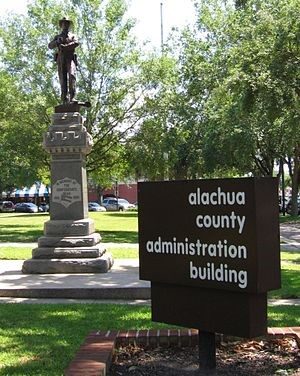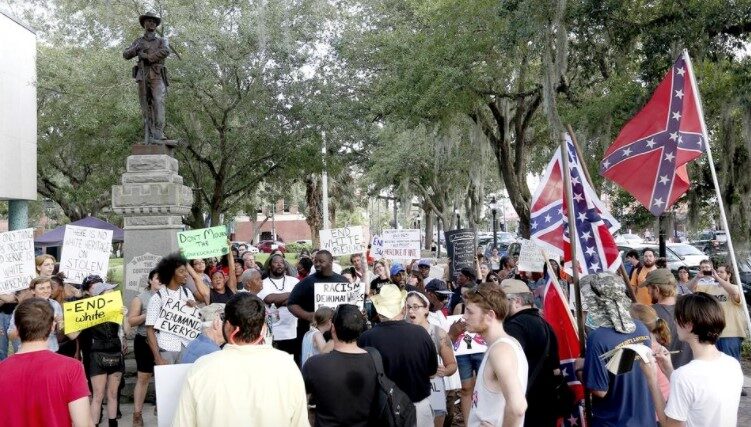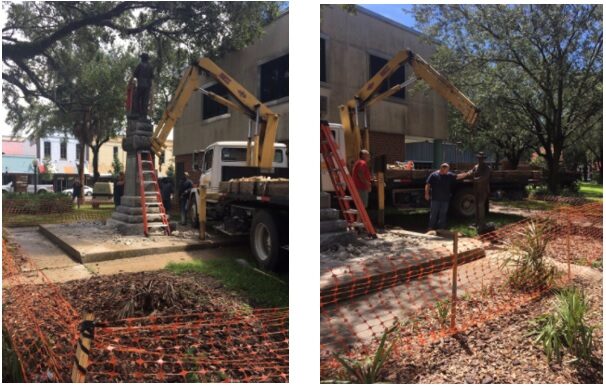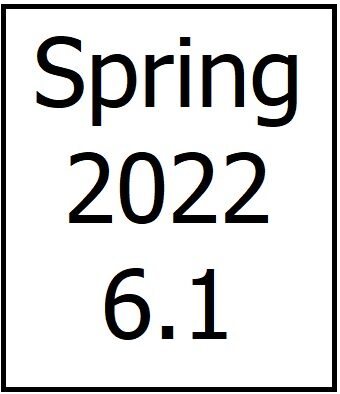The Geopolitics of White Supremacy: A Case Study on Monuments and Monumental Rhetoric
Alexander Slotkin, University of Florida
Recent national racist and anti-racist movements tied to the protection or removal of Confederate monuments across the United States speaks to the significance of these multimodal objects in our public memory. This article traces the historically dominant social energy, the cultural commonplaces or topoi responsible for producing, organizing, and animating communities, in Gainesville, Florida — a small college town with a long Confederate history — as it materializes through the creation and recent removal of a local Confederate monument nicknamed “Old Joe.” Exploring how “Old Joe” and similar monuments frame and contribute to cultural topographies as active agents of white supremacy has the potential to enrich national discourse(s) on the Confederacy by better representing our local communities and their situated topoi. At the same time, understanding how monuments create different publics by inducing affirmative or dissonant activity offers an avenue for breaking away from violent historical patterns echoing into the present.
Keywords: Public Memory; Multimodal Rhetoric; Topoi; Community.
Introduction
Rhetoric is not rhetoric until it is uttered, written, or otherwise manifested or given presence. Thus, we might hypothesize as a starting point for theorizing rhetoric that at least one of its basic characteristics (if not the most basic) is its materiality. (Blair, 1999, p. 19)
Recent national racist and anti-racist movements tied to the presence, defacement, and/or removal of Confederate monuments have demonstrated the significance behind communities making and remaking the material places and memorial spaces dotting their landscapes. The 2015 Charleston church shooting in South Carolina, for example, prompted cities like New Orleans and Baltimore to remove Confederate monuments from public property (Aguilera, 2020). Reversing course, neo-Confederates and other white supremacists would, two years later, organize the deadly “Unite the Right” rally in Charlottesville, Virginia, to protest the city’s planned removal of a statue depicting Robert E. Lee. And in Gainesville, Florida, the twelve-foot-tall Confederate statue nicknamed “Old Joe” was removed two days after the rally in Charlottesville, joining, according to USA Today, a group of around seventy-five Confederate monuments nationwide (Hampson, 2018).
Although more Confederate monuments are coming down — with the most recent wave of removals following the killing of George Floyd in 2020 (Aguilera, 2020) — I am interested as a lifelong Floridian in “Old Joe’s” relocation. After all, every national conflict over Confederate monuments emerges from, takes place within, and contributes toward local geopolitical histories. How can we ever hope to understand macro level trends without first discussing their beginnings in our local communities?
Consider that Gainesville is a settler-colony built on Seminole and Timucua land, and that early settler-colonists used mostly Black enslaved labor to develop the local plantation economy (Kirkman & Branton, n.d.; Ortiz, 2005). Today, the most noteworthy plantation, the Haile Plantation, has been reimagined as a predominantly white wealthy suburb located near the original Haile Plantation Homestead. Transforming a literal plantation into a white suburb would suggest, as Katherine McKittrick (2013) observes in “Plantation Futures,” that “the idea of the plantation is migratory” such that a “plantation logic characteristic of (but not identical to) slavery emerges both ideologically and materially” in our political geographies (p. 3). In other words, an anti-Black way of thinking and being is rooted in (for our purposes) Gainesville’s political, cultural, and geographical design, replicating plantation-like spaces. Understanding how this settler-colony is organized around an anti-Black ideology contextualizes our interactions with “Old Joe,” transforming a simple statue or neo-Confederate relic into an active agent of white supremacy.
The goal of this article is to trace the historically dominant social energy — the cultural values, beliefs, and experiences responsible for producing, organizing, and animating the life-worlds of different groups of people — circulating in Gainesville, Florida, through the construction and removal of one of the city’s most famous Confederate monuments: “Old Joe.” My aim as a white Jewish newcomer in writing this piece is to better understand how historical ideologies (in this case, white supremacy) rooted in local cultural and geopolitical contexts continue to reverberate materially and symbolically into the present.
Motivating Desires: Rhetorical Energy in Stone
Discourse surrounding public memory and its memorialization typically treats monuments as tools for forwarding narratives or beliefs about people, places, and events for specific audiences or publics (O’Brien & Sanchez, 2021; Sanchez & Moore, 2015; Bednar, 2011; Casey, 2004). To that end, public monuments frame narratives about the past in the present while also ensuring that these narratives are brought into the future. As James Chase Sanchez and Kristen R. Moore (2015) explain in their article “Reappropriating Public Memory: Racism, Resistance, and Erasure of the Confederate Defenders of Charleston Monument,” “Public monuments serve as rhetorical and material renderings of public memory, wherein, as James Young suggests, not only is public memory constructed but events are co-constructed with memories and monuments” (p. 3). In creating monuments, communities both forward and actualize specific narratives by embedding them within the monument’s materiality. Monuments, in other words, are important multimodal actors in preserving and extending public memories.
The idea that monuments have a rhetorical life of their own by materializing our memories and values is not new. In his work on roadside crash memorials, Robert M. Bednar (2011) contends that shrines take on the lives of those they represent through the production of memorial space (pp. 24-5; see also O’Brien, 2020). Edward S. Casey (2004) similarly attributes agency to objects when arguing that monuments do not “merely embody or represent an event (or person, or group of persons)…[but instead] strives to preserve its memory in times to come” (pp. 17-8). For Bednar (2011) and Casey (2004), a monument’s agency or ability to act is often constructed multimodally through the assemblage of different objects such as photographs, written messages, carvings, or even flowering plants in culturally significant locations. We can add to these rhetorical and materialist understandings of monuments by observing that monuments also organize and mobilize social activity, that is, activity that may involve the support or appropriation of public memory by different publics.
Public monuments organize and mobilize social activity by embodying topoi — what Ralph Cintrón (2010) characterizes as “storehouses of social energy” (p. 101) — through their claims to both land and power. These topoi, the literal and figurative places where people make meaning, such as in a public square or through shared expressions, are sources of energeia or physical force in their ability to actualize “‘things or [make] them appear to be engaged in an activity’” (qtd. in Olson, 2010, p. 303). Hence, in their claims to a community’s history through their visual and bodily assertion over physical space, public monuments capture and actualize a public’s social or cultural energeia by reproducing the “contradictory, collective passions and convictions that constitute a people” (Cintrón, 2010, p. 101). The materialization of a dominant community’s passions and beliefs sparks embodied reactions in viewers through their identification or disidentification with the values being exhorted, such as adorning a statue with flowers or defacing it with paint. Different publics therefore cohere through their shared support of or opposition to public monuments and the value-systems energizing these sites of public memory by adopting specific modalities (e.g., graffitiing) — reflective of their own attitudes and beliefs — for interacting with these monuments.
By embodying a community’s social energeia, monuments themselves have agency. After all, as many diverse Indigenous systems of knowledge maintain, individuals do not preexist the material world around them but instead come into being with it (see Gómez-Barris, 2017; Rìos, 2015; Wilson, 2008). Statues create communities by appealing to or challenging our values while, at the same time, our engagement with these statues solidifies their cultural capital as monuments. Because public monuments are co-constructed alongside the ideological narratives they portray (O’Brien & Sanchez, 2021; Sanchez & Moore, 2015), and because these monuments take on the social lives of what or who they are made to represent (Bednar, 2011; Casey, 2004), they become identical to these narratives in ways that induce supportive or dissident activity as determined by an individual’s relationship to the values represented in that narrative, person, or event. We might therefore identify “Old Joe” with the social energy inherited from Gainesville’s early white dominant cultural community.
Because a public’s beliefs, values, and experiences (i.e., topoi) are localized in ways that “organize and constitute our [their] imagining of social life” (Cintrón, 2010, p. 101), claims that a town’s culture is identifiable with just one bodily public or institution overlooks the production and reproduction of cultural knowledge at the level of community activity. We might reflect for example that while the Southern Poverty Law Center reported in 2019 that “Old Joe” was the only Confederate monument in Gainesville (see “Whose Heritage?”), residents know that the Confederacy is still memorialized through monuments like university buildings named after members of the Confederacy (Aspuru, 2020) or even the Southern Crosses of Honor marking local gravesites. Nonetheless, “Old Joe” stands out in local public memory, in part thanks to its location and initial reception.
Standing at just twelve feet tall, the copper statue was erected in 1904 by the United Daughters of the Confederacy (UDC), a neo-Confederate women’s group dedicated to honoring individuals who served the Confederacy (see Figure 1 below). According to the Smithsonian American Art Museum, the sculpture proclaims the following:
(Front of base:) IN MEMORY OF/THE/CONFEDERATE/DEAD/1861 1865. (Left side:) ‘THEY FELL FOR US, AND FOR THEM/SHOULD FALL/THE TEARS OF A NATION’S GRIEF.’…(Right side of base:) ‘THEY COUNTED THE COST/AND IN DEFENCE OF RIGHT/THEY PAID THE MARTYR’S PRICE.’ (Smithsonian, n.d., n.p.)
The narrative this monument is forwarding alphabetically, visually, and materially revolves around seeing Confederate soldiers — represented by an unnamed soldier in uniform — as fighting to protect the (white) public’s freedom, arguing that we, as beneficiaries of their sacrifice, should mourn them as martyrs. This message seemingly resonated with the feelings and convictions of Gainesville’s early white public, the group with perhaps the most political power at the time (see Smith, 1973; Ortiz, 2005). According to the Ocala Evening Star, the monument was unveiled after speeches by both a well-known judge and a Confederate general to a large crowd that was “highly pleased with it” (“Confederate Monument,” 1904, p. 1).
 |
| Figure 1: “Old Joe” Standing Next to the Alachua County Administration Building in Gainesville, Florida. Image from Douglas Green, Wikipedia. |
Mapping Gainesville’s Social Energy
“Old Joe’s” reception, introduction, and placement would suggest that the values we identify with Confederate ideologies are symbolically and materially embedded in Gainesville’s cultural geography — its cultural relationship to space and place. This is perhaps not surprising given that Gainesville was established by settler-colonists hoping to expand Florida’s plantation economy through Black enslaved labor (Smith, 1973, p. 11) and, later, a Confederate stronghold during two Civil War battles (Ortiz, 2005, p. 5). In fact, just twenty years before “Old Joe’s” construction, Gainesville’s agricultural economy was predicated on the legal enforcement of Black labor through vagrancy statues that locked “African Americans into subordinate positions” (p. 53), with the Gainesville Sun swearing that “‘we will be forced to force the negro to work’” (qtd. in Ortiz, 2005, p. 53). The call to reproduce the use of earlier forms of Black enforced labor through the letter of the law continues into the present, with the University of Florida benefitting from 156,684 hours of unpaid prison labor between 2015 and 2019 (Rodriguez, 2020, n.p.), although of course not all workers were Black.
Understanding these ideological and material patterns of oppression are important for contextualizing how “Old Joe” and the narratives it materializes are part of what Katherine McKittrick (2011) characterizes as “a plantation logic that spatialized the complementary workings of modernity, land exploitation, and anti-black violence” (p. 951). The statue connects the present with a Confederate past through the colonization of Indigenous land and recurring Black exploitation. “Old Joe’s” domineering presence in front of the county’s administration building dichotomizes the town and its “geographies into us/them,” hiding “secret histories that undo the teleological and biocentric underpinnings of spatiality” (McKittrick, 2013, p. 12). The topoi or social energy stored in “Old Joe” in other words is enacted and reenacted in ways that serve to reify its identity as a Confederate monument, tying Gainesville’s cultural and geopolitical landscape to anti-Black geographies in ways that try to limit Black imagination to trauma-centered narratives. These moments of reification occur in both instances of identification, such as when members of the community annually leave wreathes near the statue’s base (Caplan, 2017), or disidentification through protest (see Figure 2).
 |
|
Figure 2: The “Rally Against Racism,” organized by community members protesting “Old Joe’s” presence and met by neo-Confederate counter-protestors. Image from The Gainesville Sun. |
Anti-racist groups protested the statue’s presence in Gainesville five months prior to the beginning of the Unite the Right rally (Fig. 2), the event that would ultimately move Alachua County commissioners to vote four to one to return the statue to the UDC (Sarbak, 2017). But because “Old Joe” and the values it represents so strongly resonated with some community members, it was inevitable that protestors would be met by Confederate sympathizers and members of white supremacy groups like the Proud Boys. We might read the moment pictured in Figure 2 as an ideological contest over public memory mediated by the statue’s materiality. But rather than acting only as an object of debate, we should think of the statue itself as a rhetorical agent responsible for rematerializing historical trauma through different modes of communication, namely its inscriptions, shape, and bodily presence.
Chelsey Carter (2018) writes in her article “Racist Monuments Are Killing Us” that, as a Black woman,
I am reminded [by Confederate monuments] of my ancestors who gave their lives fighting for my freedom, but I am also insulted by the fact that the city and country that I love continues to honor a violent faction of the country that devalued my life. (p. 140)
For Carter, Confederate monuments as rhetorical agents force her and perhaps others to psychologically relive past traumas. And when we couple her observation with the fact that displays of racism directly impact people of color —especially Black people — in ways that are deleterious to their physical and psychological wellbeing (Carter, 2018; Krieger, 2012), it becomes difficult not to see “Old Joe” as an active agent in extending plantation violence. “Old Joe” and Confederate monuments more generally not only represent falsely idyllic views of history but also re-present or re-enact these narratives through their physical presence.
As an outgrowth of Gainesville’s plantation history, “Old Joe” framed the community’s understanding of who they are and are not by organizing their values, beliefs, and experiences. And like many of his contemporary counterparts, “Old Joe” would be returned to the UDC without much fanfare two days after the Unite the Right rally (see Figure 3) (CBS 4, 2017). But whereas the defacement of public monuments to the Confederacy may be seen as refutations of how certain histories are publicly memorialized and/or attempts to create new public narratives (Sanchez & Moore, 2015, pp. 3-5), the gentle relocation of Confederate monuments imbued with a community’s memory to spaces like museums or estates owned by the UDC neither uproot nor dramatically shift the social and cultural energy they embody. On the contrary, monuments that materialize white supremacist ideologies need to be torn down, smashed, and destroyed for racist public memories and localized topoi to be utterly broken, changed, or fissured.
 |
|
Figure 3: Pictured on the left are workers readying to remove the monument. The image on the right depicts “Old Joe” safely off his plinth. Images from CBS 4 News. |
Although destroying monuments is likely not the violence psychiatrist and political philosopher Frantz Fanon (1952/2008) imagined could be the source of a “collective catharsis…through which the forces accumulated in the form of aggression can be released” (p. 112), we might parallel toppling material agents of white supremacy —whether they be made of stone or copper — with a more subtle version of how colonized subjects affect change according to Fanon (1961/2004): “The colonized subject discovers reality and transforms it through his praxis, his deployment of violence and his agenda for liberation” (p. 21). After all, similarly to how “colonialism is not a machine capable of thinking…[but rather] naked violence” that only yields “when confronted with greater violence” (p. 23), white supremacy operates writ large according to the violent erasure and/or subjugation of o/Other bodies. Enacting violence against a Confederate monument creates, to use Sanchez and Moore’s (2015) language, “a palimpsestic memory” that emphasizes counter narratives such that the original, “even if restored to its original state, will never be the same, just as public memory of the monument will never be the same” (p. 5). A Confederate monument like “Old Joe” that is carefully relocated, however, prevents communities from actually and therapeutically challenging the reoccurring murmurs of plantation violence. The act and memory of smashing Confederate monuments supplants the memorialization of anti-Black violence through its erasure — a refutation of unquestionably racist discourse as well as an invitation for communities to create counter narratives or memories, “form[s] of remembering…that [ultimately] resituates the narrative of the oppressed” (O’Brien & Sanchez, 2021, p. 5).
Conclusion
The cultural and geopolitical relationships that connected Gainesville’s plantation economy to “Old Joe” fit into a larger, national conversation regarding Confederate monuments. But the seeds of this debate were planted in local plantations, where white power structures would eventually come to shape the dominant geographical culture of towns like Gainesville. Mapping the rhetorical and social energy of any cultural community requires a narrowly defined lens informed by local histories and epistemologies. My short analysis of the crossroads between the historical and contemporary narratives and events in Gainesville was only made possible by closely studying these ideological moments as they materialized in a definite, multimodal body.
Just as Sanchez and Moore (2015) call “on rhetoricians to address and engage with the Black Lives Matter movement in new ways, embracing and engaging with public memory and affect as central to the rhetorical moment” (p. 6), I ask that we direct our attention to local rhetorical acts of meaning-making to unmask and challenge white supremacy where it begins: in our earliest public memories. Rather than simple visual and/or textual adornments, local monuments create claims to both land and power that are ideologically and materially memorialized and carried into the future; they not only represent a public’s memory narrative but also (re)materialize its energeia. In the case of Confederate monuments, this entails reinvigorating historical violence while simultaneously reaching outward to “organize our sentiments, beliefs, and actions in the lifeworld” (Cintrón, 2010, p. 100).
Although this article only focused on “Old Joe,” he is tied or hyperlinked to other existing Confederate monuments in Gainesville, of which there are many. Therefore, an anti-Black and anti-Indigenous history likely frames community activity and organizing in Gainesville as well as similar college towns. We need to be cognizant of how these ideologies are materialized in our cities and their networked cultural and political geographies, as well as when to raise a hammer to them.
References
Aguilera, J. (2020, June 9). Confederate statues are being removed amid protests over George Floyd’s death. Here’s what to know. TIME. https://time.com/5849184/confederate-statues-removed/
Aspuru, A. (2020, July 3). Students continue push for UF administration to rename campus buildings. The Independent Florida Alligator. https://www.alligator.org/news/students-continue-push-for-uf-administration-to-rename-campus-buildings/article_c1c84afe-bd69-11ea-ba32-d3a19d009d91.html
Bednar, R.M. (2011). Materialising memory: The public lives of roadside crash shrines. Memory Connection, 1(1), pp. 18-33.
Blair, C. (1999). Contemporary U.S. memorial sites as examplars of rhetoric’s materiality. In J. Selzer & S. Crowley (Eds.), Rhetorical bodies (pp. 16-57). The University of Wisconsin Press.
Caplan, A. (2017, April 26). ‘Old Joe’ controversy resurfaces. The Gainesville Sun. https://www.gainesville.com/news/20170426/old-joe-controversy-resurfaces
Carter, C.R. (2018). Racist monuments are killing us. Museum Anthropology, 41(2), pp. 139-141.
Casey, E.S. (2004). Public memory in place and time. In K.R. Phillips (Ed.), Framing public memory (pp. 17-44). University of Alabama Press.
CBS 4 Gainesville. (2017, August 14). ‘Old Joe’ Confederate statue in Gainesville comes down. CBS 4 News. https://mycbs4.com/news/local/old-joe-confederate-statue-in-gainesville-coming-down-today
Cintrón, R. (2010). Democracy and its limitations. In D.J. Coogan & J. Ackerman (Eds.), The public work of rhetoric: Citizen-scholars and civic engagement (pp. 98-116). University of South Carolina Press.
Confederate Monument. Unveiled in Gainesville — many visitors present — speeches by General Bullock and Hon. W. L. Palmer. (1904, January 20). The Ocala Evening Star, p. 1.
DouglasGreen. (2005). Gainesville Confederate statue located next to Alachua County administration building. Digital Image. In Wikipedia. https://en.wikipedia.org/wiki/Confederate_monument_(Gainesville,_Florida)#/media/File:Dsg_Gainesville_Confederate_Statue_20050507.jpg
Fanon, F. (2004). The wretched of the Earth (R. Philcox, Trans.). Grove Press. (Original work published 1961)
Fanon, F. (2008). Black skin, white masks (C.L. Markmann, Trans.). Pluto Press. (Original work published 1952)
Gómez-Barris, M. (2017). The extractive zone: Social ecologies and decolonial perspectives. Duke University Press.
Hampson, R. (2018, August 6). Confederate memorials turn up faster than they can be removed a year after Charlottesville. USA Today. https://www.usatoday.com/story/news/nation/2018/08/06/confederate-memorials-list-longer-usa-public-remove/891739002/
Kirkman, K., & Branton, I. (n.d.). Enslaved laborers. Historic Haile Homestead. https://www.hailehomestead.org/enslaved-laborers
Krieger, N. (2012). Methods for the scientific study of discrimination and health: An ecosocial approach. American Journal of Public Health, 102(5), pp. 936-44.
McKittrick, K. (2013). Plantation futures. Small Axe, 17(3), pp. 1-15.
McKittrick, K. (2011). On plantations, prisons, and a Black sense of place. Social & Cultural Geography, 12(8), pp. 947-963.
O’Brien, A. (2020). (Digital) objects with thing-power: A new materialist perspective of spaces, places, and public memory. TRACE: A Journal of Writing, Media, and Ecology, 1(4). http://tracejournal.net/issues.html
O’Brien, A., & Sanchez J.C. (2021). Racial countermemory: Tourism, spatial design, and hegemonic remembering. The Journal of Multimodal Rhetorics, 5(2), pp. 4-26.
Olson, C.J. (2010). Performing embodiable topoi: Strategic indigeneity and the incorporation of Ecuadorian national identity. Quarterly Journal of Speech, 96(3), pp. 300-323.
Ortiz, P. (2005). Emancipation betrayed: The hidden history of Black organizing and white violence in Florida from reconstruction to the bloody election of 1920. University of California Press.
Rìos, G.R. (2015). Cultivating land-based literacies and rhetorics. LiCS, 3(1), pp. 60-70.
Rodriguez, N. (2020, July 6). UF to continue prison labor until 2021 at the latest. The Independent Florida Alligator. https://www.alligator.org/news/uf-to-continue-prison-labor-until-2021-at-the-latest/article_41905ef4-bf0c-11ea-8b13-53c06d4752dc.html
Sanchez, J.C., & Moore, K.R. (2015). Reappropriating public memory: Racism, resistance and erasure of the Confederate Defenders of Charleston monument. Present Tense, 5(2), pp. 1-9.
Sarbak, M. (2017, May 24). Alachua County commission votes 4-1 to remove ‘Old Joe’ Confederate statue. CBS 4 News. https://mycbs4.com/news/local/alachua-county-commission-votes-4-1-to-remove-old-joe-confederate-statue
Smith, J.F. (1973). Slavery and plantation growth in antebellum Florida, 1821-1860. University of Florida Press.
Smithsonian Institution Research Information System (SIRIS). (n.d.). Confederate soldier, (sculpture). https://siris-artinventories.si.edu/ipac20/ipac.jsp?session=1508MQ638T793.518&profile=ariall&source=~!siartinventories&view=subscriptionsummary&uri=full=3100001~!317159~!14&ri=2&aspect=Browse&menu=search&ipp=20&spp=20&staffonly=&term=Outdoor+Sculpture+--+Florida+--+Gainesville&index=OBJEC&uindex=&aspect=Browse&menu=search&ri=2
Southern Poverty Law Center. (2019). Whose heritage? Public symbols of the Confederacy. https://www.splcenter.org/20190201/whose-heritage-public-symbols-confederacy
Wilson, S. (2008). Research is ceremony: Indigenous research methods. Fernwood Publishing.
